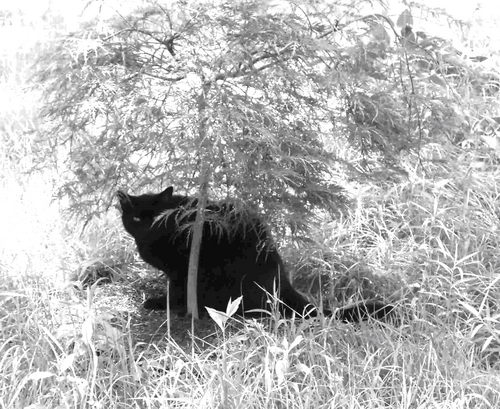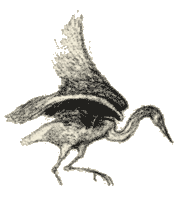This Month's Story

(a preface to DANNY AN THE ELEPHANTS)
I am leaning on the rail of the porch on the backside of the house. The view in front of me encompasses almost three quarters of our farm.
I know I’ve said this before, but this is a beautiful farm.
I’m standing here in the midmorning hours, about nine, and the sun is hitting the bright spring greenery of the trees that border the west side of the back field. There is a vibrant sense, a quiet vitality, which seems to exude from everything I see.
What is odd about this, at least to me, is that this wonderful place, this small farm of some 17 acres, is mine! The realization that this is true has been slow in coming, but as days like this spring day emerge and go by, I realize that this is true, the land I see before me is mine.
Well, let me correct that; it’s not really mine, I mean mine alone. It belongs to my wife, Stella and I. We have acceded to Pennsylvania law several years ago and had the title changed from her sole ownership (she inherited the farm from her parents) to encompass both of us.
Even after we did this, for a long time I considered the farm to be hers rather than mine; after all it was where she was born and raised. Over the last few years, as we both worked together to restore it from a derelict state to the condition I see it on this day, I have gradually developed a feeling of pride and with this growing pride, a feeling of ownership.
I guess I can go a little bit further and say that the farm also belongs to Holly, our cat. Pennsylvania law has nothing in its tenets that decree that this be so, but Stella and I have been through a very bad series of cruel events and Holly has endured these dire happenings with us and in doing so has become a close part of the collective persona that we call “us.”
Now these events are a piece of our mutual past and things are now what might be considered normal, and Holly walks about the farm, his farm, with an air that has been best described by Stella as a ‘Cat with Property.’
And so he is, and Stella and I gladly relinquish a tripartite title to the farm to him.

All things considered, I’m the new comer here.
Let me explain.
I married Stella in a church in downtown Blairsville almost forty years ago. Her parent’s farm, this farm, was just a few miles south of Blairsville, and so it was in a church in the southwestern Pennsylvania town of Blairsville in the foothills of the Laurel Highlands that we became husband and wife. The church is still there today, looking much like it did those many, many years ago.
It was a golden time, a time when the days seemed to go on forever. I had met Stella in Washington, D.C. where both she and I worked. I found her to be uncommonly pretty and rather nice, and we began doing things together, and I soon fell in love with her and she fell in love with me.
The two of us would come up to the family farm on weekends to visit her parents and grandparents. The farm was still somewhat active in those days, and I was impressed that I was served fresh eggs every morning and Stella would take me to pick huckleberries for lunch.
As I said, it was a golden time. There was a wondrous happening that I remember that took place on one of those visits that sort of personified the period.
The old wooden bridge across the creek had collapsed and Stella’s husky cousins had gathered on a long weekend to build a new bridge. They told me that they were going to build a sturdier bridge, a bridge of concrete, a bridge that would last forever. Amazingly, they did complete it that long weekend. It was quite a feat and, what was particularly nice, I helped in the building.
In the years since we have returned to live and rebuild the farm, we have reinforced and widened that narrow bridge. The present bridge is nice, wider and more practical than the old bridge; even the new railings we had specially made, come off so that we can bring in extra wide loads. But Stella and I still remember that wonderfully long weekend so many years ago when a thin boy from the big city matched cement bucket to cement bucket with Stella’s huge muscular kin.
Soon after, a portion of the Naval Laboratory I worked for in Washington was transferred to coastal Mississippi. I asked Stella to marry me and go with me south. She said yes, we went, and built a house by the coastal waters, and together we lived for thirty wonderful years in a small Mississippi town.
Then, in 2005, a savage storm destroyed our Mississippi house and washed away the small town. We were left with nothing and, in desperation, came back to the desolate small farm that Stella had inherited. Slowly, over the years we have recovered from that ordeal using the hard fought for insurance money from the house we lost, we turned the tenant-ruined farm back into the thing of beauty I see before me today.
Well, today is today; let me take a few moments to describe this seventeen-acre farm. Eight acres constitutes what we call “the back field.” While this acreage is tillable, it has not yet been tilled in my time here. The remaining frontal eight acres of the farm are best divided into two smaller units: four acres hold the new house that has replaced the old farmhouse where Stella was born, several new outhouses; a gazebo, a large vegetable garden, thirty fruit trees (plus two quite large, old apple trees), five trellised rows of different berry bushes, a pergola with a variety of grapevines for table grapes, and four long trellised rows of young grape vines from which we intend to make wine.
The last four acres contain thick woods with large, old trees, a nice sized pond with several types of fish, a second gazebo with a small pier attached, and just beyond the pond, running across the northern boundary of the farm, a narrow very pleasant creek.
These last four acres are wonderful places to take long walks to look for mushrooms and, in the case of the pond, to fish. I’ll talk about the pond and the fish and the pier in the stories on the pages of my books. I’ll also talk about the deer and the birds that live in the woods and come out and spend part of their days with us. I’ll talk about the tall, old trees that fall in the strong windstorms we have here and our converting the fallen timber into many cord of firewood that warms the house and brightens the darkest of our winter days.
There is a unique aspect of the farm: three quarters of it is surrounded by a stone fence piled an average of four feet high and six feet wide, all these same stones taken from the fields at those times when the land was being cleared for farming in the 1800’s. In the rear of the property, there are actually two stone walls; one marks the property line and the second, actually a throw line, lies next to the eight acres of tillable back field.
Stella often tells people that if they dig down a foot or so anywhere on the farm, they’ll hit a stone. I disagree, since I’ve had to dig a large number of fence post holes on the farm, I think a foot as a description of average depth is being kind.
Big stones, little stones, flat stones, round stones; they’re there, waiting for someone foolish enough to try to dig a hole.
We have grown so used to these ubiquitous subsurface artifacts, that we have named the farm “Stone Hill.” Try putting up a post and you will have to smash the stone you come upon using what I’ve been told is a “Pennsylvania Shovel,” a six-foot long, heavy, pointed iron bar.
Worse yet, try planting a garden. Stella has a forty-by-forty-foot fenced vegetable garden that I had to dig by hand. That is, I literally sat down in the dirt and manually sifted the soil a foot and a half down to extract from beneath the surface those stones larger than a quarter pound.
We have abundant water.
Several springs feed our pond and creek. There is a shallow, hand-dug well, and we have an eighty-foot-deep well that, with the aid of an electric pump, gives us a reliable supply of very good water. To water Stella’s garden, the berry bushes and the grape vines, we have run an underground pipe line to the creek and when needed, a pump in the creek sends water some 400 feet to the garden as well as the surrounding plants.
The old farmhouse is gone. It was our refuge when we sorely needed shelter. We were very happy to accept it as a haven during those desperate times when we had nothing. We lived in that old farm house for three years, despite the fact that it was in deplorable condition. When we finally received our hard fought for insurance money from our destroyed Mississippi house, we began rebuilding a new house, a house, which in spirit, replicated our washed away Mississippi house.
In 2008, when our new home was completed, we regretfully had the old farmhouse demolished. As we watched it being razed, we were surprised how really poor a condition the structure had been. We wondered how we could have been so content in a house in its condition. But the truth is that Stella and I had a great feeling of regret for having to do what we did; the farmhouse had been our home at a time when we desperately needed a home.
We don’t have many neighbors. Our farm is situated high on a hill and, with the exception of the people living in the three houses down the hill and across the county road, there is no neighbor closer than a quarter mile. Most of our neighbors are farmers with their own lands and cattle and, because of the large spaces between us, visits between us are few. Yet in the years we have lived here, we’ve found these neighboring farmers to be wonderful people, and in my new books, you will read about them and the pleasure we have had living among them.
So, read these stories about our good and our bad times. Read them with the knowledge that Stella and I are now quite happy and that with these stories we wish to share our history and the ambience of our present life with you.
Paul Estronza La Violette
Stone Hill
April, 2012
